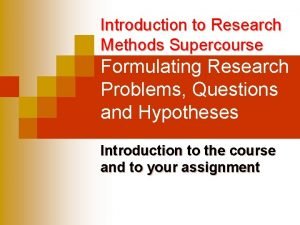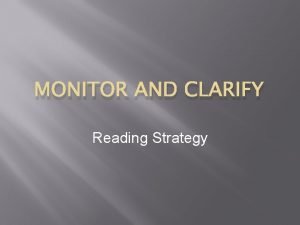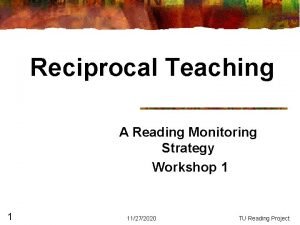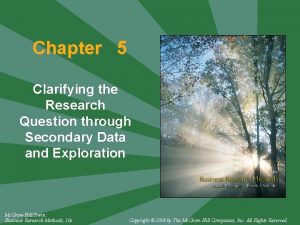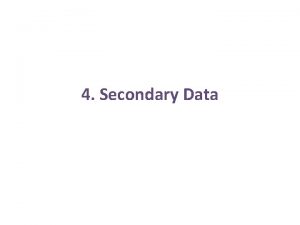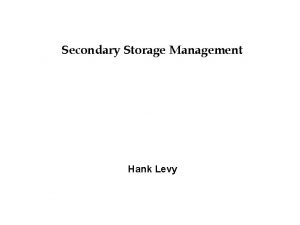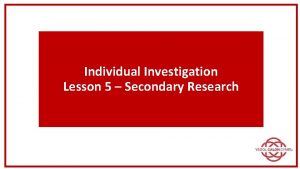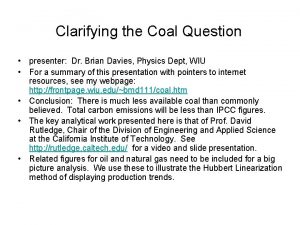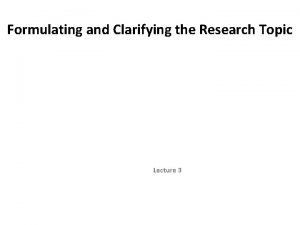Chapter 5 Clarifying the Research Question through Secondary



























- Slides: 27

Chapter 5 Clarifying the Research Question through Secondary Data and Exploration Mc. Graw-Hill/Irwin Business Research Methods, 10 e Copyright © 2008 by The Mc. Graw-Hill Companies, Inc. All Rights Reserved.

2 Learning Objectives Understand. . . • The purpose and process of exploratory research. • The two types and three levels of management decision-related secondary sources. • The five types of external information and the factors for evaluating the value of a source and its content.

3 Learning Objectives Understand. . . • The process of using exploratory research to understand the management dilemma and work through the stages of analysis necessary to formulate the research question (and, ultimately, investigative questions and measurement questions). • What is involved in internal data mining and how internal data-mining techniques differ from literature searches.

4 Exploratory Phase Search Strategy Discovery/ Analysis Secondary Sources Expert Interview Search Strategy Individual Depth Interviews Group Discussions

Integration of Secondary Data into the Research Process 5

6 Objectives of Secondary Searches • Expand understanding of management dilemma • Gather background information • Identify information that should be gathered • Identify sources for and actual questions that might be used • Identify sources for and actual sample frames that might be used

7 Conducting a Literature Search Define management dilemma Consult books for relevant terms Use terms to search Locate/review secondary sources Evaluate value of each source and content

8 • Whiteboard technology makes the discussion of symptoms relevant to the managementresearch question hierarchy easier

9 Levels of Information Primary Sources: Memos Letters Interviews Speeches Laws Internal records Secondary Sources: Encyclopedias Textbooks Handbooks Magazines Newspapers Newscasts Tertiary Sources: Indexes Bibliographies Internet search engines

10 Integrating Secondary Data

11 Information Sources Indexes/ Bibliographies Directories Dictionaries Types Handbooks Encyclopedias

12 Evaluating Information Sources Purpose Format Scope Evaluation Factors Audience Authority

13 The Evolution of Data Mining Evolutionary Step Investigative Question Enabling Technologies Characteristics Data collection (1960 s) “What was my average total revenue over the last five years? ” Computers, tapes, disks Retrospective, static data delivery Data access (1980 s) “What were unit sales in California last December? ” Relational databases (RDBMS), structured query language (SQL), ODBC Retrospective, dynamic data delivery at record level Data navigation (1990 s) “What were unit sales in California last December? Drill down to Sacramento. ” Online analytic processing (OLAP), multidimensional databases, data warehouses Retrospective, dynamic data delivery at multiple levels Data mining (2000) “What’s likely to happen to Sacramento unit sales next month? Why? ” Advanced algorithms, multiprocessor computers, massive databases Prospective, proactive information delivery

14 Data Mining in Business

15 Data-Mining Process

16 The Business Research Process

17 Stage 1: Clarifying the Research Question Management-research question hierarchy process begins by identifying the management dilemma

18 Management-Research Question Hierarchy

19 Formulating the Research Question

20 Types of Management Questions

21 The Research Question Break questions down Examine variables Determine necessary evidence Fine-Tuning Set scope of study Evaluate hypotheses

22 Gantt Chart Mind. Writer Project Plan

23 Key Terms • • • • Bibliography Bibliographic Database Data Mart Data Mining Data Visualization Data Warehouse Dictionary Directory Encyclopedia Expert interview Exploratory research Handbook Index Individual depth interview • • Investigative questions Literature search Management question Measurement question – Custom-designed – Predesigned • • Primary sources Research questions Secondary sources Source evaluation – – – Purpose Scope Authority Audience Format • Tertiary sources

Appendices 5 a & 5 b Bibliographic Database Searches/ Advanced Searches Mc. Graw-Hill/Irwin Business Research Methods, 10 e Copyright © 2008 by The Mc. Graw-Hill Companies, Inc. All Rights Reserved.

25 Searching Databases vs. the Web

26 Advanced Searching Process

27 Review of Advanced Search Options
 Clarifying the research question
Clarifying the research question General question in research
General question in research Formulating and clarifying the research topic
Formulating and clarifying the research topic Formulating and clarifying the research topic
Formulating and clarifying the research topic Formulating and clarifying the research topic
Formulating and clarifying the research topic Directional and non directional hypothesis
Directional and non directional hypothesis Formulating and clarifying the research topic
Formulating and clarifying the research topic Question
Question Factor-isolating
Factor-isolating Roles and responsibilities slide
Roles and responsibilities slide Spellers clarifying phrase
Spellers clarifying phrase Purposeful listening examples
Purposeful listening examples Monitor and clarify
Monitor and clarify What is this font?
What is this font? Brand knowledge
Brand knowledge Sin entered through one man
Sin entered through one man Classes of furcation
Classes of furcation Conversion of timber
Conversion of timber Who wrote the poem night of the scorpion
Who wrote the poem night of the scorpion Present simple question words
Present simple question words Nudging probe questions
Nudging probe questions Contoh open-ended question
Contoh open-ended question Direct questions into indirect questions
Direct questions into indirect questions Compelling vs supporting questions
Compelling vs supporting questions Compelling vs supporting questions
Compelling vs supporting questions Hát kết hợp bộ gõ cơ thể
Hát kết hợp bộ gõ cơ thể Bổ thể
Bổ thể





